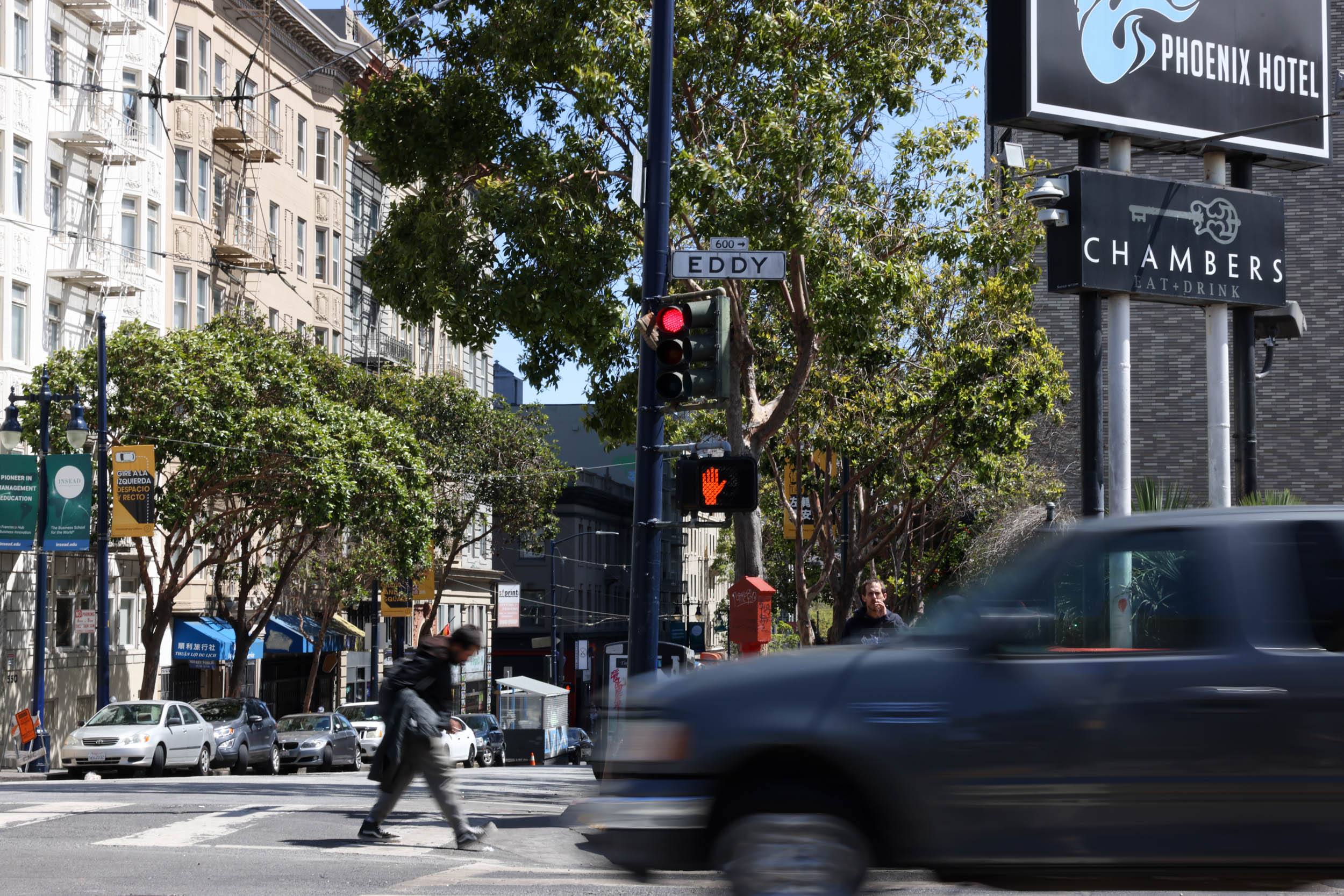It was 4 a.m. when Brendan O’Callaghan was hit in his Subaru Forester while trying to get on the Bay Bridge. The driver sped off.
His car dented, he called 9-1-1 in the hopes that police could track down the driver on the deserted nighttime streets and with the aid of toll cameras. But the response he got from the California Highway Patrol and the San Francisco Police Department was disappointing.
“Ultimately, nothing happened,” O’Callaghan said. “I was just rather surprised. Wouldn’t you guys want to find someone that is doing something like a hit-and-run? It seems to me that that type of driver is also a problematic driver in a variety of other places.”
Traffic enforcement has plummeted in San Francisco over the last decade, and virtually fell off a cliff during the pandemic. At a Feb. 2 police commission meeting, Chief of Police Bill Scott pinned the decline on Covid lockdown, staffing shortages and the police department’s new “Focus on Five,” a new policy requiring that at least half of traffic stops be related to the five most dangerous driving maneuvers.
But while enforcement is down, dangerous driving sure isn’t.
That’s the feeling among many residents who have witnessed—or experienced themselves—risky driving, including hit-and-runs, crashes, blown stop signs or other incidents. And some are taking matters into their own hands, buying dashcams, building do-it-yourself “infrastructure” and even teaming up to investigate hit-and-runs.
When Jackson Borchardt was rear-ended last November, he immediately jumped into action. Borchardt started chasing down the driver who had hit him—but it turned out that driver, too, had been rear-ended. They joined forces to find the minivan that had initiated the crash when a fourth character arrived: Orlando.
Orlando, who declined to give his last name, had been driving his Tesla when he witnessed the crash and had caught the whole thing on his built-in dash camera. He offered to give Borchardt the footage to show his insurance company, which ultimately paid Borchardt out for the needed fixes.
Orlando said he’s helped other strangers in similar situations.
“I’ve volunteered because I’d like someone to do that if I was involved,” he said. “I just think it provides eyes that no one can lie about.”
Kevin, a store associate at San Francisco’s Best Buy who declined to give his last name, said his store carries around a dozen models of dash cameras—ranging from around $50 to a few a hundred dollars —and they’re fairly popular, with store employees often hired to install them in cars.
Dash cameras aren’t just useful to drivers. Magnus Line bought a Cycleiq dash camera late last year for his bike so that he can show the footage as proof if he is targeted or hit while biking. While the camera is always rolling, he hasn’t had to use the footage thus far. But Line said he would let police know about the footage or use it as proof to an insurance company if needed.
“I’ve just had way too many close calls,” Line said.
Even when cameras are present, it’s still up to police and traffic enforcement to take action.
O’Callaghan said he was surprised the person who hit him got away with it in such a camera-heavy area that was nearly deserted at 4 a.m. If it were to happen again, O’Callaghan said he’d try harder to get a visual description—not just the license plate number—of the person who hit him.
“I just assumed it would be an easy catch,” O’Callaghan said.
Some San Franciscans are calling for better infrastructure—not necessarily more enforcement—to address the street safety problem, like better visibility at intersections, lower speed limits or physical barriers.
Automated cameras can be helpful, but are limited: State legislation to allow a five-year pilot to install speed cameras in San Francisco and a handful of other cities has failed three times since 2017 due to concerns about privacy and equity. SFMTA maintains a limited camera enforcement program that includes red-light cameras at select intersections and Muni cameras that can capture lane violations.
On Page Street, which is open only to local traffic and people traveling on foot or bike, resident Molly Hayden brought out her gardening skills to stop people in cars from zooming along the street.
She and fellow resident Jess Jenkins have helped put up colorful barriers, including concrete planters, where the Slow Street intersects with other avenues. The idea is to make the street feel welcoming, but also to make drivers think twice before using the Slow Street.
“SFPD can’t be around all the time,” Jenkins said. “Automated enforcement has potential, but it feels like we’re so far away from [progress] there as a state and a city. For us, it’s all about the infrastructure.”
Dangerous street conditions have even driven some San Franciscans to take to the streets in protest. The same day the Golden State Warriors paraded down Market Street in celebration of their national title, a smaller, more somber demonstration was planned. It was in remembrance of a motorcyclist who died at Eddy and Larkin Streets and in protest of unsafe streets in San Francisco. The protesters, part of the group Safe Street Rebel, blocked the intersection for one green light cycle.
Brett Bertocci, who was out organizing that day, said he was hit by a car while riding his bike last year.
“I went home and I organized an action to block the street somewhere else,” Bertocci said. “I can’t do anything about this short term, but what I can do is make sure you can’t do this again in the future.”
